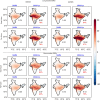Temporal and spatial aggregation of rainfall extremes over India under anthropogenic warming
- PMID: 38822065
- PMCID: PMC11143250
- DOI: 10.1038/s41598-024-63417-w
Temporal and spatial aggregation of rainfall extremes over India under anthropogenic warming
Abstract
India experienced several unprecedented floods in the recent decades. The increase in the extreme rainfall events (EREs) is the primary cause for these floods, manifesting its societal impacts. The daily downscaled and bias corrected (DBC) Coupled Model Intercomparison Project Phase 6 (CMIP6) rainfall and sea surface temperature (SST) are prepared for the Indian region and are utilized to examine the characteristics of EREs. The DBC products capture the characteristic features of EREs for the baseline period, which inspired us to assess the EREs over India in CMIP6 future projections. Consistent with the observations, DBC product shows ~ 8% of Indian land found to experienced extremely heavy rainfall associated with the long duration EREs in the baseline period. However, area and extreme rainfall thresholds are projected to increase by about 18(13)% and 58(50)%, respectively in the far future under SSP5-8.5 (SSP2-4.5) emission scenario relative to the baseline period. A two-fold-65(62)% increase in long-duration EREs compared to the short-duration EREs and substantial warming ~ 2.4(2.9) oC of Indian Ocean SSTs in the far future under SSP5-8.5 (SSP2-4.5) emission scenario compared to baseline period are reported. These findings may provide fundamental insights to formulate national climate change adaptation policies for the EREs.
© 2024. The Author(s).
Conflict of interest statement
The authors declare no competing interests.
Figures






Similar articles
-
Changes in physical characteristics of extreme rainfall events during the Indian summer monsoon based on downscaled and bias-corrected CMIP6 models.Sci Rep. 2025 Jan 29;15(1):3679. doi: 10.1038/s41598-025-87949-x. Sci Rep. 2025. PMID: 39880898 Free PMC article.
-
Improvement in the skill of CMIP6 decadal hindcasts for extreme rainfall events over the Indian summer monsoon region.Sci Rep. 2023 Dec 8;13(1):21737. doi: 10.1038/s41598-023-48268-1. Sci Rep. 2023. PMID: 38065984 Free PMC article.
-
Current and future trends in heat-related mortality in the MENA region: a health impact assessment with bias-adjusted statistically downscaled CMIP6 (SSP-based) data and Bayesian inference.Lancet Planet Health. 2023 Apr;7(4):e282-e290. doi: 10.1016/S2542-5196(23)00045-1. Lancet Planet Health. 2023. PMID: 37019569
-
A meta-analysis of the regional extreme rainfall events in the Indian sub-continent during the southwest monsoon period.Sci Total Environ. 2025 May 15;977:179339. doi: 10.1016/j.scitotenv.2025.179339. Epub 2025 Apr 15. Sci Total Environ. 2025. PMID: 40239497 Review.
-
Projected urban exposure to extreme precipitation over South Asia.Sci Total Environ. 2022 May 20;822:153664. doi: 10.1016/j.scitotenv.2022.153664. Epub 2022 Feb 3. Sci Total Environ. 2022. PMID: 35124033
Cited by
-
Changes in physical characteristics of extreme rainfall events during the Indian summer monsoon based on downscaled and bias-corrected CMIP6 models.Sci Rep. 2025 Jan 29;15(1):3679. doi: 10.1038/s41598-025-87949-x. Sci Rep. 2025. PMID: 39880898 Free PMC article.
References
-
- Wernberg T, et al. An extreme climatic event alters marine ecosystem structure in a global biodiversity hotspot. Nature Clim. Change. 2013;3:78–82. doi: 10.1038/nclimate1627. - DOI
-
- Haddow G, Bullock JA, Haddow K. Global Warming, Natural Hazards, and Emergency Management. CRC Press; 2017.
-
- Liang S, Wang D, Ziegler AD, Li LZX, Zeng Z. Madden–Julian Oscillation-induced extreme rainfalls constrained by global warming mitigation. Npj Clim. Atmos. Sci. 2022;5:67. doi: 10.1038/s41612-022-00291-1. - DOI
LinkOut - more resources
Full Text Sources

